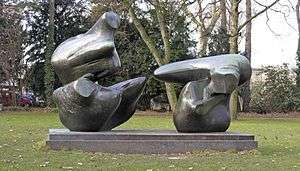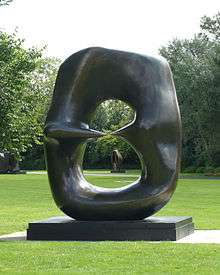Two-Piece Reclining Figure: Points
|
| |
| Artist | Henry Moore |
|---|---|
| Year | 1969-70 |
| Type | Bronze |
| Dimensions | 365 cm (144 in) |
Two-Piece Reclining Figure: Points is a sculpture by Henry Moore, catalogued as LH 606, and created in 1969-70.[1]
Editions
It was a bronze edition of 7; the artist's copy ("0/7") is in Kew Gardens in London, loaned by the Henry Moore Foundation[2] another in the Hofgarten, Düsseldorf (illustrated),[3] and one at the Hirshhorn Museum and Sculpture Garden in Washington D.C.[4][5] The plaster model is at the Art Gallery of Ontario.[6] In 2008, an example traveled to the New York Botanical Garden,[7][8] and the Denver Botanic Gardens.[9][10]
History
Among Moore's post war abstract bronzes, it is a part of the Two Piece Reclining Figure series.[11] It can be read as one figure or two.[12]
I did the first one in two pieces almost without intending to. But after I had done it, then the second one became a conscious idea. I realised what an advantage a separated two- piece composition could have in relating figures to landscape. Knees and breasts are mountains. Once these two parts become separated you don't expect it to be a naturalistic figure; therefore you can justifiably make it look like a landscape or a rock. If it's a single figure, you can guess what it's going to be like. If it's in two pieces there's a bigger surprise, you have more unexpected views; therefore the special advantage over painting--of having the possibility of many different views--is more fully explored. The front view doesn't enable you to foresee the back view. As you move round it, the two parts overlap or they open up and there's space in between.[13]
Reviews
Gift of Joseph Hirshhorn, 1974
A work like Two Piece Reclining Figure: Points, from 1969, has the feel that Moore aimed at — but didn't always achieve — of form as primal matter.[14]
See also
- List of public art in Washington, D.C., Ward 2
- Two-Piece Reclining Figure No. 9
- Reclining Figure 1969–70
References
- ↑ "Henry Moore - Works in Public - Two Piece Reclining Figure: Points 1969-70 (LH 606)". henry-moore.org.
- ↑ "What's On". kew.org.
- ↑ "Henry Moore - Works in Public - Two Piece Reclining Figure: Points 1969-70 (LH 606)". henry-moore.org.
- ↑ http://hirshhorn.si.edu/visit/in_depth.asp?key=33&subkey=102
- ↑ http://www.hirshhorn.org/visit/collection_object.asp?key=32&subkey=10387
- ↑ "Henry Moore Sculpture Centre - AGO Art Gallery of Ontario". ago.net.
- ↑ artguru. "Henry Moore in New York". artadox.com.
- ↑ "Moore to love". Time Out New York.
- ↑ "Art Tour: Henry Moore at Denver Botanical Gardens". elysianstudiosart.com.
- ↑ Cheryl McWilliams. "EWESPECIAL". ewespecial.blogspot.com.
- ↑ "Sculpture is like a journey". Detroit Metro Times.
- ↑ A Garden for Art, Valerie J. Fletcher, LOC # 97-61991, p.72
- ↑ http://mailchristies.com/LotFinder/lot_details.aspx?intObjectID=1609508
- ↑ "Making the Most of Henry Moore". TIME.com. 2 January 2008.
External links
This article is issued from Wikipedia - version of the 9/22/2016. The text is available under the Creative Commons Attribution/Share Alike but additional terms may apply for the media files.

